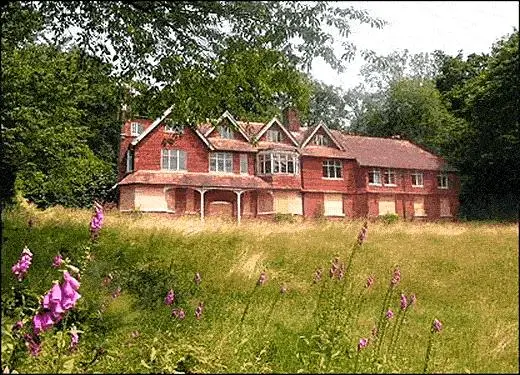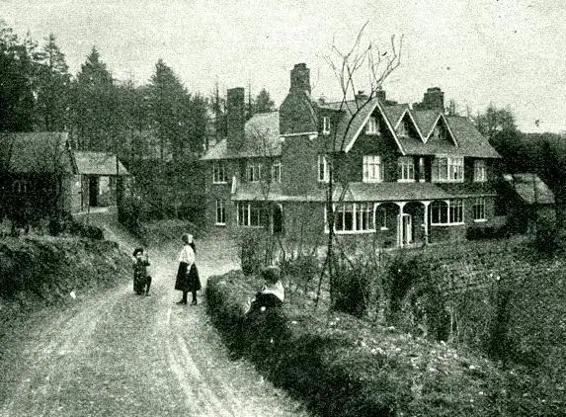Say, "Elementary, my dear Watson." Chances are, everyone will know that you're supposed to be Sherlock Holmes. No matter that Holmes wore a cap only once in the original stories, that his pipe of choice was not a calabash, and that he never uttered that phrase. He did, however, use a magnifying glass occasionally.
Like other pop culture icons, Holmes and Watson have evolved since their creation over a century ago. Their characters have changed, as have the qualities for which audiences admire them. Below appear some of the best-known permutations of Holmes and Watson, as they have traveled from print to stage and radio, to film and television, and back to print again. It would be impossible to list every version here, so some guidelines have been included for further investigation. The game is afoot! Happy sleuthing.
Conan Doyle Slept Here
The fate of Undershaw, Conan Doyle's home from 1896 to 1906, is uncertain. Although his mother, Mary Foley Doyle, claimed to trace her lineage back to the royal Plantagenets through her mother's side, and loved to tell her eldest child tales of British history, Conan Doyle wasn't royalty, by any stretch of the imagination. When he became a wealthy man, he had to create his own estate.

The fate of Conan Doyle's home from 1896 to 1906, which he had a minor hand in designing, is still in doubt. After learning in 1893 that his wife Louise ("Tooie") might not live out the year, Conan Doyle first took her to Switzerland, whose dry air and high altitudes were more healthful for consumptives than the damp climate of England. When friends told him about the mild, dry microclimate of Hindhead, Surrey, he decided to build a home there. In 1895, Conan Doyle bought land and chose an architect to build Undershaw. Under her husband's watchful care, Tooie lived another decade, and died at Undershaw in 1906.

[from Wikipedia:] Doyle commissioned the construction on the site by architect Joseph Henry Ball, whom Doyle described as "...an old friend and a man of most fastidious taste and critical turn of mind who will keep a constant eye upon the work." Built in the style 'Surrey-vernacular', the house is largely composed of red brick and is asymmetrical. A factor in the construction were the large south-facing windows which let in plentiful light, intended to provide a cheerful indoor environment. The windows also featured specially manufactured stained glass with a coat of arms said to be that of Doyle's family; many of these have not survived the attacks of vandals in recent years.
Undershaw's main entrance opened into an entry hall of two stories with a brick fireplace. Doyle's home also included a generator for the electric lighting, which was not common outside of cities at the time, and a dining room which could seat thirty people. A special display shelf in the wood-paneled drawing room, located near the ceiling, displayed a collection of weapons, stuffed birds, walrus tusks and various trophies. The doors of the house were also unusual in that they open both ways. The current internal layout has 14 bedrooms, with a size of 10,000 square feet (930 m2).
Doyle's three-storey home featured a grand staircase of shallow steps, to prevent Louise Doyle from becoming winded on the way upstairs. It also boasted a billiards room and Doyle's private book-lined study, where the author wrote some of his best-known work.
Doyle lived at Undershaw for a decade between 1897 and 1907 (Louise died in 1906). The house was the place where many of Doyle's most famous works were composed including The Great Boer War, The Hound of the Baskervilles, The Adventures of Gerard, The Return of Sherlock Holmes and Sir Nigel. Doyle also entertained many notable house guests at Undershaw including Sherlock Holmes illustrator Sidney Paget, the famous Sherlock Holmes actor William Gillette and the creator of Dracula, Bram Stoker. Other notable visitors included E.W. Hornung, J.M. Barrie, Thomas Wemyss Reid, Gordon Guggisberg, Churton Collins, Virginia Woolfe and Bertram Fletcher Robinson.
Undershaw was converted into a hotel not long after Doyle sold it. During 2004, the hotel closed and the property was purchased by Fosseway Limited - it has remained unoccupied since that sale. On 18 August 2010 the Los Angeles Times reported that plans are underway to redevelop the home into a multi-unit apartment building, stating "The hammers start raining blows on Undershaw as early as next month."
The plan is opposed by preservationists, who want to see the home converted into a museum dedicated to Sir Arthur Conan Doyle. However, in June, 2010 the Waverley Borough Council declined to buy Undershaw from the developer. The council's chief of planning, Matthew Evans, stated "We don't have that kind of money. We have to tighten our belts." But councillor Jim Edwards, the only vote against the planning officers’ recommendations, took the preservationists' side, saying "This house has got tremendous historical importance.
1 comment